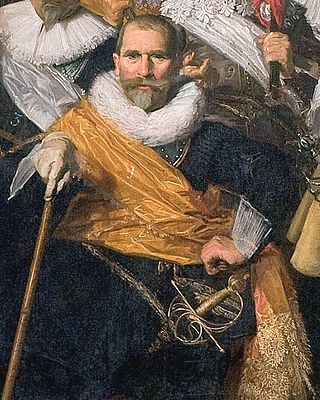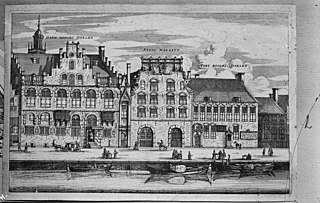
Frans Hals the Elder was a Dutch Golden Age painter. He lived and worked in Haarlem, a city in which the local authority of the day frowned on religious painting in places of worship but citizens liked to decorate their homes with works of art. Hals was highly sought after by wealthy burgher commissioners of individual, married-couple, family, and institutional-group portraits. He also painted tronies for the general market.

Cornelis Corneliszoon van Haarlem was a Dutch Golden Age painter and draughtsman, one of the leading Northern Mannerist artists in the Netherlands, and an important forerunner of Frans Hals as a portraitist.

Schutterij refers to a voluntary city guard or citizen militia in the medieval and early modern Netherlands, intended to protect the town or city from attack and act in case of revolt or fire. Their training grounds were often on open spaces within the city, near the city walls, but, when the weather did not allow, inside a church. They are mostly grouped according to their district and to the weapon that they used: bow, crossbow or gun. Together, its members are called a Schuttersgilde, which could be roughly translated as a "shooter's guild". It is now a title applied to ceremonial shooting clubs and to the country's Olympic rifle team.

The Banquet of the Officers of the St George Militia Company in 1616 refers to the first of several large schutterstukken painted by the Dutch painter Frans Hals for the St. George civic guard of Haarlem, and today is considered one of the main attractions of the Frans Hals Museum, Haarlem.

Jacob Pietersz Olycan, was a brewer, magistrate, and later mayor of Haarlem, best known today for his portrait by Frans Hals, pendant to the portrait of Aletta Hannemans, whom he married in Zwolle in 1624.

Pieter Jacobsz Olycan, was a Dutch brewer, magistrate, and later mayor of Haarlem, best known today for his portraits by Frans Hals, as well as for the portraits of his wife Maritge Claesdr. Voogt.

Banquet of the officers of the Calivermen Civic Guard, Haarlem formerly known as The Banquet of the Officers of the St Adrian Militia Company in 1627, refers to a schutterstuk painted by Frans Hals, in 1627, for the St. Adrian civic guard of Haarlem. Today it is considered one of the main attractions of the Frans Hals Museum, in Haarlem.

The Officers of the St Adrian Militia Company in 1633 refers to the second schutterstuk painted by Frans Hals for the Cluveniers, St. Adrian, or St. Hadrian civic guard of Haarlem, in 1633, and today considered one of the main attractions of the Frans Hals Museum there.

Nicolaes Woutersz van der Meer was a Dutch brewer, magistrate and mayor of Haarlem, best known today for his portrait with its pendant of his wife Cornelia Claesdr Voogt, both painted by Frans Hals in 1631.

The Banquet of the Officers of the St George Militia Company is an oil-on-canvas painting by the Dutch artist Frans Hals, painted from 1626 - 1627, during the Dutch Golden Age. Today, the piece is considered one of the main attractions of the Frans Hals Museum.

The Officers of the St George Militia Company in 1639 refers to the last and largest schuttersstuk painted by Frans Hals for the St. George civic guard of Haarlem, and today is considered one of the main attractions of the Frans Hals Museum in Haarlem.

Johan Claesz van Loo, was a Dutch brewer, owning De Drie Leliën in Haarlem, best known today for his portrait painted by Frans Hals.

Andries van Hoorn, or van der Horn, was a Dutch mayor of Haarlem, known best today for his portraits by Frans Hals.

The Meagre Company, or The Company of Captain Reinier Reael and Lieutenant Cornelis Michielsz Blaeuw, refers to the only militia group portrait, or schutterstuk, painted by Frans Hals outside of Haarlem. Today the painting is in the collection of the Amsterdam Museum, on loan to the Rijksmuseum, where it is considered one of its main attractions of the Honor Gallery. Hals was unhappy about commuting to Amsterdam to work on the painting and, unlike his previous group portraits, was unable to deliver it on time. The sitters contracted Pieter Codde to finish the work.

The Haarlem schutterij refers to a collective name for the voluntary civic guard of Haarlem, from medieval times up to the Batavian Revolution in 1794, when the guilds of Haarlem were disbanded.

Willem Claesz Vooght (1572–1630), was a mayor of Haarlem best known today for the portrait painted of him by the painter Frans Hals.

Aletta Hanemans (1606–1653), was a Dutch brewer. She became the brewer of the Hoeffijser in Haarlem. She is best known today for her marriage portrait by Frans Hals, painted when she married the brewer, magistrate, and later mayor of Haarlem, Jacob Pietersz Olycan in 1624.

Johan Schatter, was a Dutch Golden Age brewer from Haarlem.

Nicolaes Olycan was a Netherlands brewer of Haarlem.

The Voetboogdoelen was a 16th-century building on the Singel canal in Amsterdam, at the corner of Heiligeweg near Koningsplein square, which served as headquarters and shooting range of the local schutterij. Frans Hals painted a group portrait for the Voetboogdoelen, known as the Meagre Company.





















